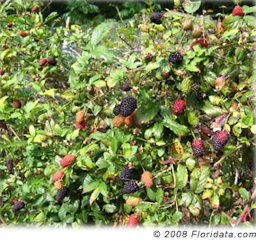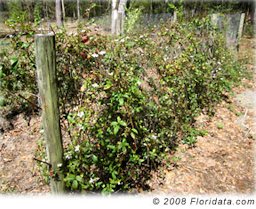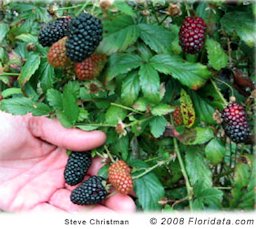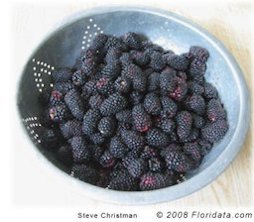From Floridata
by
Steve Christman
Rubus fruticosus
Common
Names: blackberry, bramble
Botanical
Family: Rosaceae, the rose Family
Description
Most
blackberry cultivars, like their wild relatives, grow as thorny canes,
some trailing, others more or less erect. There are thornless
varieties, and varieties adapted to most parts of the temperate world.
Some cultivars are entirely self-fruitful, and others require a
different variety nearby for cross pollination. Important cultivars for
southern North America include the thorny varieties 'Oklawaha',
'Flordagrand', 'Chickasaw', 'Kiowa' and 'Brazos', and the thornless
cultivars 'Apache', 'Arapaho' and 'Navaho'.

By late spring to early summer the stems are heavy with ripening blackberries.

Steve grows his blackberries against a 4 ft tall wire fence that permits easy and painfree harvest.
Location
There are many species of wild Rubus
growing in temperate climates in the Northern Hemisphere, and a few
species found at high elevations in the tropics. The cultivated
blackberries of North America have a complex pedigree that includes
several American and European species in the subgenus Rubus, within the genus Rubus. Collectively, the cultivated and wild microspecies of subgenus Rubus, the "blackberries", are referred to as Rubus fruticosus. Some wild North American species are: Allegheny blackberry (Rubus allegheniensis); highbush blackberry (R. betulifolius); American dewberry (R. canadensis); sand blackberry R. cuneifolius; northern dewberry (R. flagellaris); swamp blackberry (R. hispidus); and southern dewberry (R. trivialis), all native to eastern North America. Mayes dewberry (R. almus); R. leucodermis; and R. ursinus are native to western North America. The European bramble (Rubus fruticosus)
also figured in the development of modern blackberry cultivars, and, as
mentioned above, lent its botanical name to the whole group. Commercial
production of blackberries in the U.S. is mainly in the Pacific
Northwest, Michigan, New York and Arkansas where they are grown
primarily for processing into preserves, jams, pies and the like. .
Culture
Light: Maximum fruit production comes from berries grown in full sun.
Moisture: Blackberries
can withstand periods of reduced rainfall, but should get at least an
inch (2.5 cm) of rain or irrigation per week when they are developing
fruit.
Hardiness: USDA
Zones 3 - 9. There are blackberry cultivars adapted to all but the
driest temperate climates, and researchers are trying to develop
cultivars for the subtropics and tropics. Blackberry blossoms are
susceptible to late frosts and freezes, and are damaged by temperatures
below 28 F (-2 C).
Propagation: Blackberries
are very easy to propagate. One way is by tip layering: Remove pieces
of canes that have rooted on their tips where they touched the ground.
Most cultivars spread by suckering from the roots, and these suckers
may be severed from the mother plant. Six inch (15 cm) lengths of roots
cut from the mother plant can be planted out.
Usage
Once
picked, blackberries deteriorate rapidly and so are not generally
suitable for shipping to distant markets. Wild blackberries are
harvested everywhere they occur, but if you want truly great tasting,
easy-to-pick, uniformly large berries, you need to grow one or more of
the cultivars that have been developed for the home gardener.
Blackberries are easy to grow. They are perennial plants that live for
many years. They produce their flowers and fruits on canes (called
floricanes) that were formed the previous year. The floricanes die back
after fruiting and new primocanes replace them. The primocanes may be
cut back near their tips to encourage branching, but this must be done
well before winter dormancy since the flower buds for the next season
will have already formed by then. Some authorities recommend cutting
out the floricanes after harvesting the fruit. Others advise mowing the
whole crop after harvest, which would include the developing primocanes
too. I don't prune mine at all and I get great yields every year.
(Cardinals nest in the tangled jungle of old and new canes.) The
trailing blackberry varieties especially, and even the semi-erect types
should be trellised. I grow mine on a 4' (120 cm) high fence of chicken
wire, periodically donning gloves and training the crop by pushing
primocane tips through the fence.

Selected
varieties, like these 'Oklawaha' blackberries produce heavier crops of
larger, more uniform fruit compared to wild plants.

A bowl of beautiful blackberries poses for pictures just prior to becoming pie.
Features
Among the more than 250 species in the genus Rubus,
are several grown not for their fruit, but for their ornamental values
including beautiful and fragrant flowers, handsome foliage and even
showy stems. Many of the ornamental Rubus come from China.
Raspberries belong to the subgenus Idaeobatus,
and differ from blackberries in that the fruit, when picked, separates
readily from the receptacle, as opposed to blackberries in which the
receptacle remains attached to the fruit and is consumed along with it.
The typical red raspberry of North America and Europe is Rubus idaeus. Loganberries are hybrids between blackberries and raspberries.
|
|